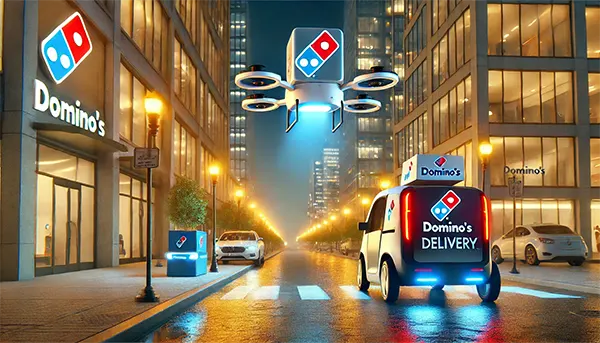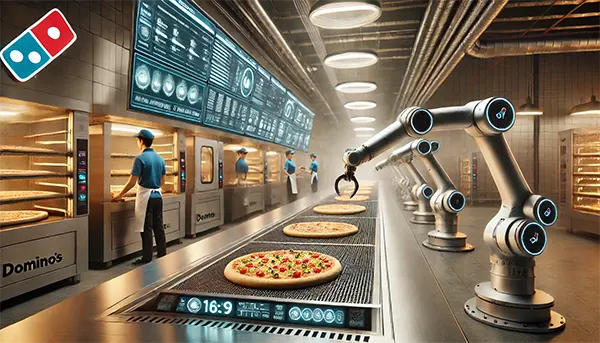
From Pizza Delivery to Autopilots: How Domino’s Pizza Innovates
Domino’s Pizza is more than just a restaurant chain—it is a technology-driven company that has pioneered drone and robot deliveries. From artificial intelligence-driven ordering systems to self-driving delivery vehicles, Domino’s continues to set new standards in food tech. This article explores how the company is revolutionising the pizza industry with cutting-edge innovations.
Why Domino’s Invests in Artificial Intelligence and Autonomous Delivery
Domino’s has embraced artificial intelligence (AI) and automation to enhance its delivery services. With increasing demand for efficiency, AI-powered solutions help streamline order processing, predict customer preferences, and optimise delivery routes. The company’s investment in AI is driven by the need to improve customer experience and reduce operational costs.
The introduction of self-driving delivery robots marks a significant step forward. In partnership with Nuro, Domino’s has deployed autonomous vehicles in select locations, allowing customers to receive their orders without human intervention. These electric vehicles use advanced sensors and machine learning to navigate roads safely.
Drone deliveries have also been a key innovation for Domino’s. In 2016, the company made history by completing the first commercial pizza delivery by drone in New Zealand. Since then, drone delivery trials have expanded, showcasing the potential for faster and more efficient order fulfilment.
The Impact of AI and Automation on Customer Experience
AI is transforming the way customers interact with Domino’s. The company has developed AI-powered chatbots that take orders via voice recognition, allowing for hands-free ordering. This feature is particularly useful for customers who prefer a seamless digital experience.
AI also plays a crucial role in quality control. Domino’s uses machine learning to analyse pizza images before they are delivered, ensuring that orders meet quality standards. This technology helps maintain consistency and improves customer satisfaction.
Furthermore, predictive analytics allow Domino’s to anticipate peak ordering times and adjust staffing levels accordingly. By leveraging AI, the company enhances efficiency while reducing food waste and wait times.
The Success of Domino’s Mobile App and Online Ordering
Domino’s has prioritised digital transformation, with its mobile app and online ordering platform becoming key revenue drivers. The app provides a user-friendly interface, allowing customers to customise their pizzas, track orders in real time, and access exclusive discounts.
The introduction of GPS tracking has revolutionised the delivery process. Customers can monitor their driver’s location and estimated arrival time, ensuring greater transparency and convenience. This feature has been instrumental in increasing customer trust and satisfaction.
Domino’s loyalty programme further strengthens its online presence. Customers earn points for every purchase, which can be redeemed for free pizzas. The success of this programme highlights the effectiveness of digital engagement in building long-term customer relationships.
How Domino’s Leads in Digital Innovation
Domino’s has consistently been ahead of the curve in digital innovation. The introduction of voice-activated ordering via smart assistants like Amazon Alexa and Google Assistant has made the ordering process even more convenient.
In addition, Domino’s “AnyWare” technology allows customers to place orders through multiple platforms, including smart TVs, smartwatches, and even social media. This omnichannel approach ensures accessibility across various digital touchpoints.
Another noteworthy development is Domino’s investment in augmented reality (AR). The company has experimented with AR-powered menu visualisation, enabling customers to see a 3D representation of their customised pizzas before placing an order.

Rebuilding Brand Reputation After the 2000s Crisis
Domino’s faced a major brand crisis in the early 2000s, struggling with declining customer satisfaction and negative reviews. To turn things around, the company launched a transparent marketing campaign acknowledging its past mistakes and committing to quality improvement.
The introduction of the “Pizza Turnaround” campaign in 2009 was a game-changer. Domino’s openly admitted its shortcomings and showcased behind-the-scenes efforts to enhance ingredients and recipes. This honesty resonated with customers, leading to a significant boost in sales and brand perception.
Customer feedback became central to Domino’s strategy. The company implemented real-time review tracking and integrated feedback-driven improvements into its menu. This customer-centric approach helped Domino’s rebuild trust and reclaim its position as a market leader.
The Role of Innovation in Brand Recovery
Technology played a key role in Domino’s comeback. The introduction of digital ordering and delivery innovations positioned the company as a forward-thinking brand. This shift not only improved operational efficiency but also attracted tech-savvy customers.
Domino’s marketing efforts focused on transparency and engagement. The brand introduced live order tracking, allowing customers to see every stage of their pizza’s journey—from preparation to delivery. This level of openness reinforced trust and loyalty.
In addition, Domino’s embraced social media to connect with its audience. The company actively engages with customers, responds to queries, and uses digital campaigns to drive engagement. By leveraging technology, Domino’s successfully revitalised its brand and set new industry standards.
